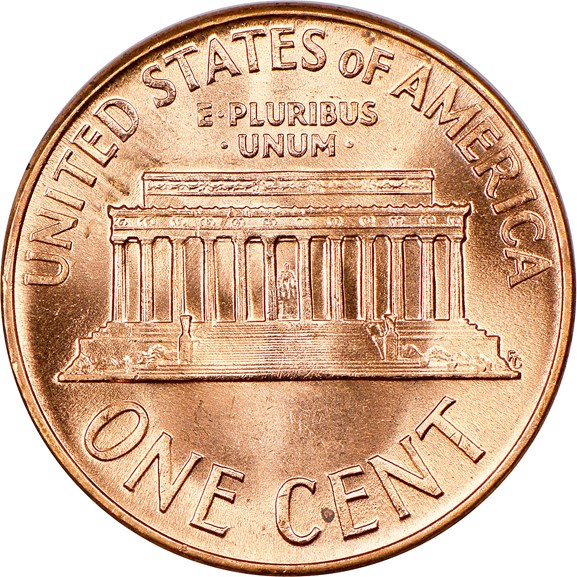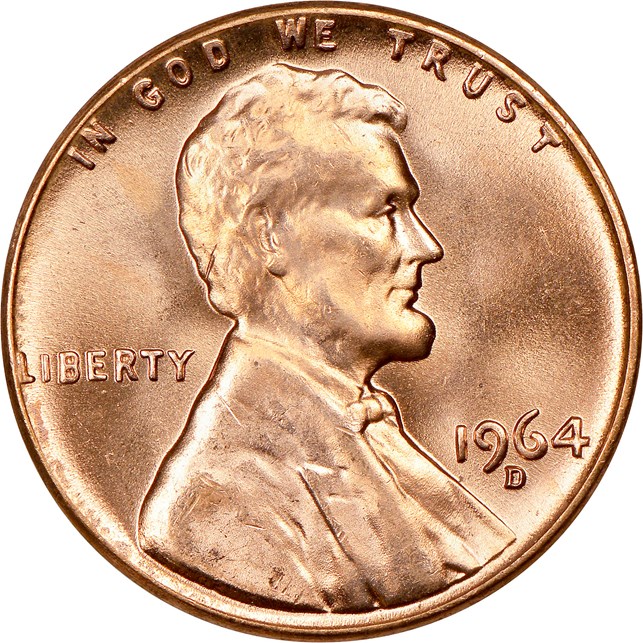USA Coin Album: A Memorial to the Memorial Cent--Conclusion
Posted on 6/13/2017


Collectors have a sentimental attachment to the old Wheat Ear cents of 1909-58, but no such affection is felt for the Memorial cents. Of course, they are collectable, but the primary interest seems to be in the very highest grades, where participants in the online coin registries maintained by the two major grading services compete for a top scoring position. A coin that may be purchased by the hundreds grading Mint State 65 RD (red) might bring some nominal price that barely merits the cost of having it graded, yet the same issue certified as MS 67 RD is worth many multiples of that figure. For example, as this is written the NGC Price Guide value of a 1964-D cent jumps from $15 in MS 65 RD to $1500 in MS 67 RD! NGC's Census Report currently shows 8 pieces certified in the higher grade, and that represents quite a score for persons who likely pulled these coins from original rolls of 1964-D cents.
The hoarding of recent cents by the roll of 50 coins or even the mint-sealed bag of 5000 pieces was at its height in the early 1960s, and there are still many such rolls lying idle in old collections. This activity had reached such a frenzy by 1964 that speculators were taking out bank loans to buy massive quantities of BU (Brilliant Uncirculated) cents through half dollars as soon as they were minted and shipped. When this market began to tumble later that year and collapsed almost completely during 1965-67, thousands of people were left quite literally holding the bag. As anyone who has tried to assemble a gem set of Lincoln Memorial cents will attest, the vast majority of surviving Mint State examples, though they may be fully red, are rather spotted and even stained. The value of such pieces is negligible, and raw examples may be found in many a dealer's junk box priced at 25 cents, this figure being nothing more than a handling charge.
The BU roll craze of the 1960s has been replaced with a new mania—the "registry set grade." Not too long ago I would have laughed at the notion of any Lincoln Memorial cent other than a popular variety being listed singly and illustrated in an auction catalog, yet this is the new reality. "Top-pop" examples of otherwise extremely common coins draw very fierce competition among those who want the ultimate rank in online registries and must buy their way to it. While the paying of large premiums for the finest examples of a coin is nothing new, what has changed is the great disparity in prices within an ever-narrowing range of grades. A Classic Head cent of 1808-14 grading MS 67 is indeed a wonder coin, and that's true largely because there are so few grading even MS 65. In the case of Lincoln Memorial cents, however, MS 65 RD coins are plentiful, and it's harder to understand why the value jumps in such huge increments over just two grades. This is a bit reminiscent of the 1960s roll craze, though it will likely have a stronger foundation in the long run.
When my book The Complete Guide to Lincoln Cents was published in 1996, there were very few Lincoln Memorial cents being submitted to grading services. They simply weren't worth enough to justify the expense, and collectors were not yet ready to pay huge premiums for top grades. When describing each Lincoln Memorial cent in my book, I typically noted that it was readily available in gem condition. Collectors reading my book today sometimes ask how I could say such a thing, since so many issues are rare in the highest grades. I have to explain that no one was considering grades above MS 65 RD at that time, as no market then existed for them and so few dates were worth enough to have graded at the regular fees. The introduction of bulk grading, where large quantities of such coins could be submitted with instructions to certify only those pieces achieving a specified minimum grade, arrived right about the time my book was printed. This lowered the cost enough to make a market in modern coins, and the debut of certified registries came shortly afterward.
My own two collections of Lincoln Memorial cents are entirely uncertified, and I doubt that any of the pieces would attract the interest of registry collectors. I have my original set in an old coin album, the last page of which ends at the year 2000. I have another, nicer set that is stored in plastic tubes. I use these coins for study and photographing from time to time, but this collection ends at 1998, the last year I purchased the Mint's annual Uncirculated Set.
David W. Lange's column, “USA Coin Album,” appears monthly in The Numismatist, the official publication of the American Numismatic Association.
Stay Informed
Want news like this delivered to your inbox once a month? Subscribe to the free NGC eNewsletter today!
